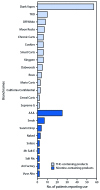E-cigarette Product Use, or Vaping, Among Persons with Associated Lung Injury - Illinois and Wisconsin, April-September 2019
- PMID: 31581166
- PMCID: PMC6776374
- DOI: 10.15585/mmwr.mm6839e2
E-cigarette Product Use, or Vaping, Among Persons with Associated Lung Injury - Illinois and Wisconsin, April-September 2019
Abstract
In July 2019, the Illinois Department of Public Health and the Wisconsin Department of Health Services launched a coordinated epidemiologic investigation after receiving reports of several cases of lung injury in previously healthy persons who reported electronic cigarette (e-cigarette) use, or vaping (1). This report describes features of e-cigarette product use by patients in Illinois and Wisconsin. Detailed patient interviews were conducted by telephone, in person, or via the Internet with 86 (68%) of 127 patients. Overall, 75 (87%) of 86 interviewed patients reported using e-cigarette products containing tetrahydrocannabinol (THC), and 61 (71%) reported using nicotine-containing products. Numerous products and brand names were identified by patients. Nearly all (96%) THC-containing products reported were packaged, prefilled cartridges, and 89% were primarily acquired from informal sources (e.g., friends, family members, illicit dealers, or off the street). In contrast, 77% of nicotine-containing products were sold as prefilled cartridges, and 83% were obtained from commercial vendors. The precise source of this outbreak is currently unknown (2); however, the predominant use of prefilled THC-containing cartridges among patients with lung injury associated with e-cigarette use suggests that they play an important role. While this investigation is ongoing, CDC recommends that persons consider refraining from using e-cigarette, or vaping, products, particularly those containing THC. Given the diversity of products reported and frequency of patients using both THC- and nicotine-containing e-cigarette products, additional methods such as product testing and traceback could help identify the specific cause of this outbreak.
Conflict of interest statement
All authors have completed and submitted the International Committee of Medical Journal Editors form for disclosure of potential conflicts of interest. No potential conflicts of interest were disclosed.
Figures

References
-
- Layden JE, Ghinai I, Pray I, et al. Pulmonary illness related to e-cigarette use in Illinois and Wisconsin—preliminary report. New Engl J Med 2019. Epub September 6, 2019. https://www.nejm.org/doi/full/10.1056/NEJMoa1911614 - DOI - PubMed
MeSH terms
Substances
LinkOut - more resources
Full Text Sources
Medical
Miscellaneous

